Reference no: EM13802825
Introduction:
One of the original purposes of the potentiometer was to measure an unknown voltage using a known voltage as a reference. The potentiometer comprises a series of precision resistors which can be placed in series with a precision slide-wire resistor to create a known resistance. The instrument is connected to known and unknown voltages and the resistors are adjusted until the voltages are in balance. It is used in conjunction with a galvanometer which indicates when zero current flows and that the variable resistance is correctly adjusted. One advantage of using a potentiometer circuit to determine the value of an unknown voltage source is that, when the potentiometer circuit is balanced, no current flows through the circuit which avoids inaccurate measurements due to internal resistances. More common applications of the potentiometer can be seen in the volume control on a radio or stereo, although this has been superseded by digital controls which click up or down.
Today's experiment expands on the techniques introduced in the laboratory, Measurement of Resistance, again using concepts given by Ohm's and Kirchhoff's laws.
Aims
Today's laboratory aims to teach students how to connect a variety of electrical circuits in order to undertake reliable electrical measurements. This exercise is primarily a practical one which will:
(a) provide experience in wiring up a potentiometer circuit,
(b) use that circuit to measure unknown emfs,
(c) use a potentiometer to calibrate an ammeter
The Concept of a Potentiometer
1. State the difference between the terms, electromotive force (emf) and terminal voltage, when referring to a battery? Include a reason for the numerical difference between the two in your answer and an equation relating the emf, ε, to the terminal voltage, V.
2. Calculate the correction that must be made to a voltmeter of coil resistance 3 k?, with a reading of 1.5 V, when it is being used to measure the emf of a cell of internal resistance 10 ??
A potentiometer circuit is a circuit designed to measure the potential difference between two points without drawing any current from the circuit containing them. The potentiometer circuit is such a useful circuit that it is often pre-packed into a box which enables numerous refinements that make it easier to use and increase the accuracy of measurements. The ‘box' is called a potentiometer.
3. If the two points mentioned before are the two terminals of a cell, what does the potentiometer measure?
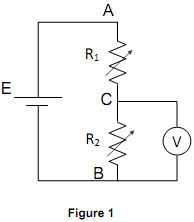
4. State the relationship between the potential difference (PD) between C and B and the value of R2? Note: The current has a constant value.
5. Why was the instruction to keep R1 + R2 = constant (1110 ?) included?
6. Using a conventional definition, which of the two points, C or B, has the higher potential? Why?
7. State the range of PDs that can be tapped between C and B?
8. Based on the decade boxes supplied from figure 1 determine the smallest increment of PD that can be tapped?
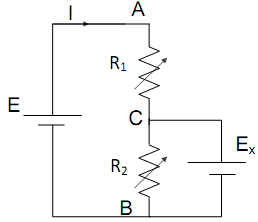
9. Describe what will happen to the current through the battery, Ex, if the PD between C and B is adjusted to equal the PD of the battery Ex? Note: This point, which is normally recorded by noting the value of R2, is known as the balance point.
10. Determine the relationship between the PD of the battery and its emf under these conditions of balance.
11. State the relationship between Ex, the current drawn from the driving battery, I, and the value of R2 at balance, Rx? Note: The resistor sum is 1110 ?.
12. Imagine the cell Ex is replaced with another cell, Es (an accurately known standard cell) and the value of R2 re-adjusted until balance is obtained, changing the value of R2 to Rs. How would you compare this outcome to the equivalent relationship in question 11?
13. Write down Ex, therefore, in terms of Rx, Rs and Es?
Procedure: Part 1
The circuit illustrated in figure 3 enables you to meet the requirements of questions 9 to 13.
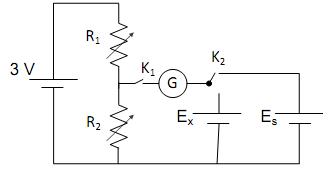
K2 is a two-way switch that enables the connection of either Ex or Es into the circuit. The galvanometer, a sensitive device for measuring current, is represented by G. The normal position of K1, a tapping key, is open.
(a) Wire up the circuit shown in figure 3 and set R1 and R2 each to 555 ?. Show your circuit to the demonstrator before proceeding.
(b) Connect Ex and adjust R1 and R2, ensuring their sum remains equal to 1110 ? until a balance point is obtained. This value of R1 is Rx. Record this reading.
(c) Connect Es and balance the circuit for Es, keeping the sum of R1 and R2 equal to 1110 ?. This value of R, is Rs. Record this reading.
(d) Use the expression obtained in preliminary question 13 to evaluate Ex, the emf of the unknown cell.
(e) Repeat steps (b) to (d) at least twice which will enable you to estimate the uncertainty in Ex.
Procedure: Part 2
The purpose of this section is to use the potentiometer to calibrate an uncalibrated ammeter, that is, to find a relationship between the correct current flow through an ammeter, I, and the reading on the ammeter Im. The basis for this exercise is the relationship outlined in question 1 of this part of the procedure.
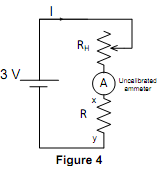
R is a standard resistor whose value is known to high-precision. The function of RH, a variable resistor, commonly called a rheostat, is to control the current, I, through the circuit.
Questions
1. State the relationship between the current, I, and the PD, using the symbol Vxy, across the standard resistor, R.
2. Can this PD be measured accurately with a voltmeter? If not, why not?
(a) Connect the circuit shown in figure 4 to the circuit in figure 3 using the same 3 V power supply; i.e. connect the points X and Y to replace the unknown cell. This enables the circuit in figure 3, the potentiometer, to determine the PD across R. The overall combined circuit is illustrated in figure 5.
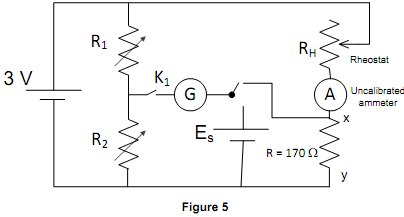
(b) Take six measurements of Vxy using a variety of values of Im in the range 1 to 10 mA by adjusting the rheostat, which will enable you to calculate the correct current flowing through the ammeter circuit, I. Tabulate your results, including uncertainties, in the following table.
|
Meter reading Im
(mA)
|
Rx at balance
(0)
|
Vxy
(V)
|
lxy
(mA)
|
Meter correction
lxv - Irn (mA)
|
|
|
|
|
|
|
|
|
|
|
|
|
|
|
|
|
|
|
|
|
|
|
|
|
|
|
|
|
|
|
|
|
|
|
|
|
|
|
|
|
|
|
|
|
|
|
|
|
|
|
|
|
|
|
(c) Plot a meter correction graph, showing Ixy - Im on the vertical axis and Im on the horizontal axis.
(d) Write a brief conclusion to this laboratory session explaining what a potentiometer is useful for.